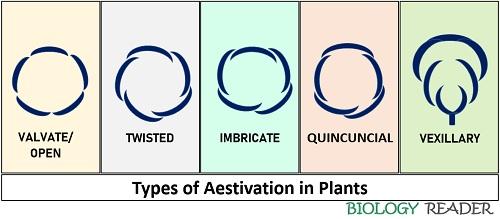Aestivation in plants can be defined as the arrangement of the petals and sepals, collectively called as perianth inside a floral bud before blooming. It is an important tool in the study of plant taxonomy, in which flowers of the different family show distinct aestivation. For instance, the sepals and petals of the Hibiscus flower belonging to the Malvaceae family show valvate and twisted aestivation, respectively. The term aestivation is more or less similar to the term vernation, which describes the organization of the leaves inside a vegetative bud. In this context, we will discuss all types of aestivation that the sepals or petals of a floral bud exhibit.
In plants five common forms of aestivation are found viz. valvate, twisted, imbricate, vexillary and quincuncial.
Content: Aestivation in Plants
Definition of Aestivation
Aestivation is one of the floral characteristics, which demonstrates the organization of calyx (sepals) and corolla (petals) relative to each other, in a floral bud. Calyx and corolla are collectively called as perianth. In a floral diagram, it is one of the property that is taken into consideration to show the relationship between the sepals and petals.
Perianth
The calyx plus corolla constitutes the outermost whorl, i.e. perianth. In some plants, sepals and petals are found as auxiliary whorls, or we can say they are non-differentiated.
Example: Flowers of Polyanthus, Crinum, etc.
Sometimes sepals closely resemble the petals and are brightly coloured as in Gloriosa superba (Liliaceae ), Crinum asiaticum (Amaryllidaceae), etc. Flowers of Amaranthaceae family possess a membranous and persistent type of perianth.
The outermost whorl, i.e. perianth, will be termed as polyphyllous if the sepals and petals remain free, as in flowers of Gloriosa superba. But, if the sepals and petals are found fused as in the flowers of Polyanthes tuberosa, then the perianth will be termed as gamophyllous.
Types of Aestivation
The positional organization of sepals and petals are of following types :

Valvate
It is an open kind of aestivation, which includes flowers whose sepals and petals are only attached through the margins in a single whorl by leaving a free space within them. In simple words, the edges of calyx and corolla are very close within a floral whorl but do not intersect each other.
Example: Mustard, Annona and Calotropis flower
Twisted
It is also called contorted or convolute aestivation. It includes the flowers whose sepals or petals are organized in such a way, in which one edge overlaps the next edge inside. Thus they regularly overlap the neighbouring members on one side.
Example: Flowers of Hibiscus, ladyfinger and cotton.
Imbricate
In this kind of aestivation, the outermost whorl or perianth includes petals and sepals that overlap each other in a way that few petals are entirely inside and some are entirely outside. Thus, the overlapping of calyx or corolla in imbricate aestivation is non-specific, i.e. not occur in a specific position. Descending imbricate and ascending imbricate aestivation are the two common subtypes.
Example: Flowers of Gulmohar.
Vexillary
It is also known as papilionaceous or descending imbricate aestivation. In this type, the overlapping of petals starts from the posterior end towards the anterior side. It includes such flowers, in which the odd posterior petal intersects the margin of two lateral petals. A pair of smallest anterior petals are overlapped by the two lateral petals or wings. Therefore, in such an arrangement the largest or odd posterior petal is entirely outside, while the keel or anterior pair of petals are fully inside.
Example: Flowers of Tephrosia, Crotalaria and Dolichos.
Quincuncial
It also refers as ascending imbricate aestivation and just contradicts the arrangement in descending imbricate aestivation. In this type, the overlapping of petals begins from the anterior end to the posterior end. In this type, the whorl of perianth is spirally arranged and not in a single whorl. The odd posterior petal is first intersected by the margins of two lateral petals, which in turn is intersected by the anterior pair of petals. Thus, in such an arrangement the odd posterior petal is entirely inside, the two lateral petals are partly external, and one of the two anterior petals is completely outside.
Example: Flowers in Cassia and Delonix.
Conclusion
Therefore, we can conclude that the aestivation is the specific arrangement of perianth members, i.e. sepals and petals with respect to each other. It is one of the factors, through which one can classify flowers, based on the type of aestivation.